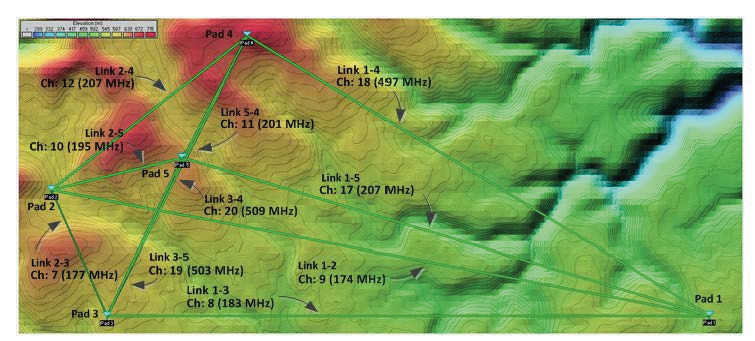White space exploration opportunities, Part 2
Published by David Bizley,
Senior Editor
Oilfield Technology,
William M. Brown, Metric Systems Corp., explores the opportunities provided by the use of the white space spectrum in the Marcellus Shale region.
A basic white space network example
An end-to-end (point-to-point, or multipoint) wireless communications system, a system operating in the VHF/UHF range versus microwave (1 GHz and higher) will have a marked advantage in operating range and ability to penetrate natural and man-made ground clutter. Current licensed, cellular LTE systems operating in the 470 and 700 MHz band in the US and internationally, take advantage of improved UHF propagation physics in urban areas to push through and establish viable communications in high rises and dense urban complexes.

Figure 2. Five production pads in Clinton PA interconnected in a broadband mesh network operating over non and near line-of-sigh paths using available White Space VHF and UHF spectrum.
The white space spectrum provides the communication planner with three intrinsic system propagation benefits over microwave spectrum:
- A 10 – 40 times range extension over microwave.
- Superior clutter and structure penetration.
- Near and non line-of-sight capability, especially in the low and high VHF bands.
All of which make the use of white space spectrum a serious alternative technology in the environs of the Marcellus Shale play region.
Network example
To appreciate the inherent operational benefits of white space spectrum in a varied topology a broadband mesh network model interconnecting five actual production pads in mid-central Clinton County, PA has been constructed. The basic model shown in Figure 2 contains 10 viable pad-to-pad broadband links; each link providing a payload bandwidth of 4 - 6 T1s. Table 2 presents the results of each link evaluated (using a Longley-Rice Propagation Model in an 80% forested region) for usability on the basis of signal level, fade margin and spectrum. For example, in Figure 3, Link 1 - 2 from pads 1 and 2, runs a 6.5 mile uphill stretch grazing about 1 mile of tree line. Using site antenna heights of 60 ft and an antenna gain of 6 dB at each site, each White Space band provides a potentially usable link with a 10 dB fade margin. Table 2 also shows that unlicensed operation in the 2.4 - 8 GHz spectrum presents a margin deficient, which would require taller antennas and/or higher gain antennas, or diversity system to overcome inherent path loss and achieve equivalent operation, thus increasing deployment capital and labour expense.

Figure 3. 10 Km grazing path between Pads 1 and 2 at 174 - 216 MHz.

Figure 4 illustrates inherent capability of VHF and low end UHF transmissions to tolerate reasonable path obstructions. The path between Pads 2 and 3 is obscured by gently rolling hills spanning approximately 0.5 km or 0.3 miles obscuring an otherwise line-of-sight path. Path analysis shows that the combined VHF ground- wave and air- wave provide a potential 16.4 dB fade margin sufficient for sustainable high payload bandwidth operation.

Figure 4. Non-line-of-sight path between Pads 2 and 3 at 174 - 216 MHz.
Part 3 of this article can be reached here.
Part 1 of this article can be reached here.
Adapted by David Bizley
Read the article online at: https://www.oilfieldtechnology.com/exploration/22112013/space_exploration_part_2/
You might also like
Union Jack Oil plc sign farm-in agreement with Reach Oil and Gas for the Sark Drilling Project
The agreement is to acquire a 60% working interest (paying 80%) in the Sark well, planned to be drilled early 3Q25, located in Central Oklahoma, US.


